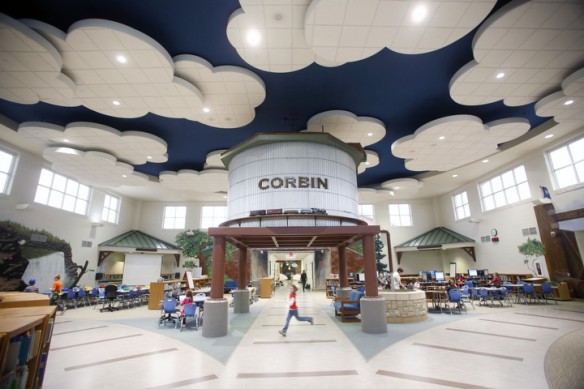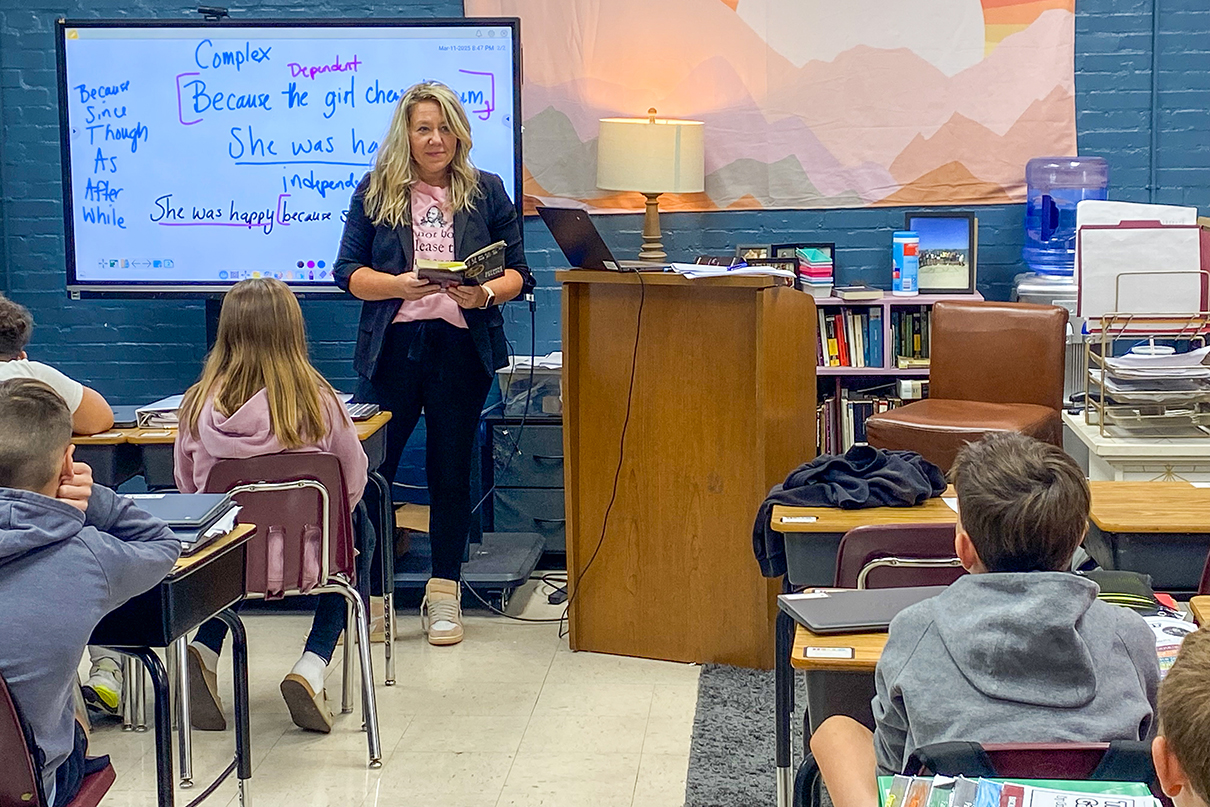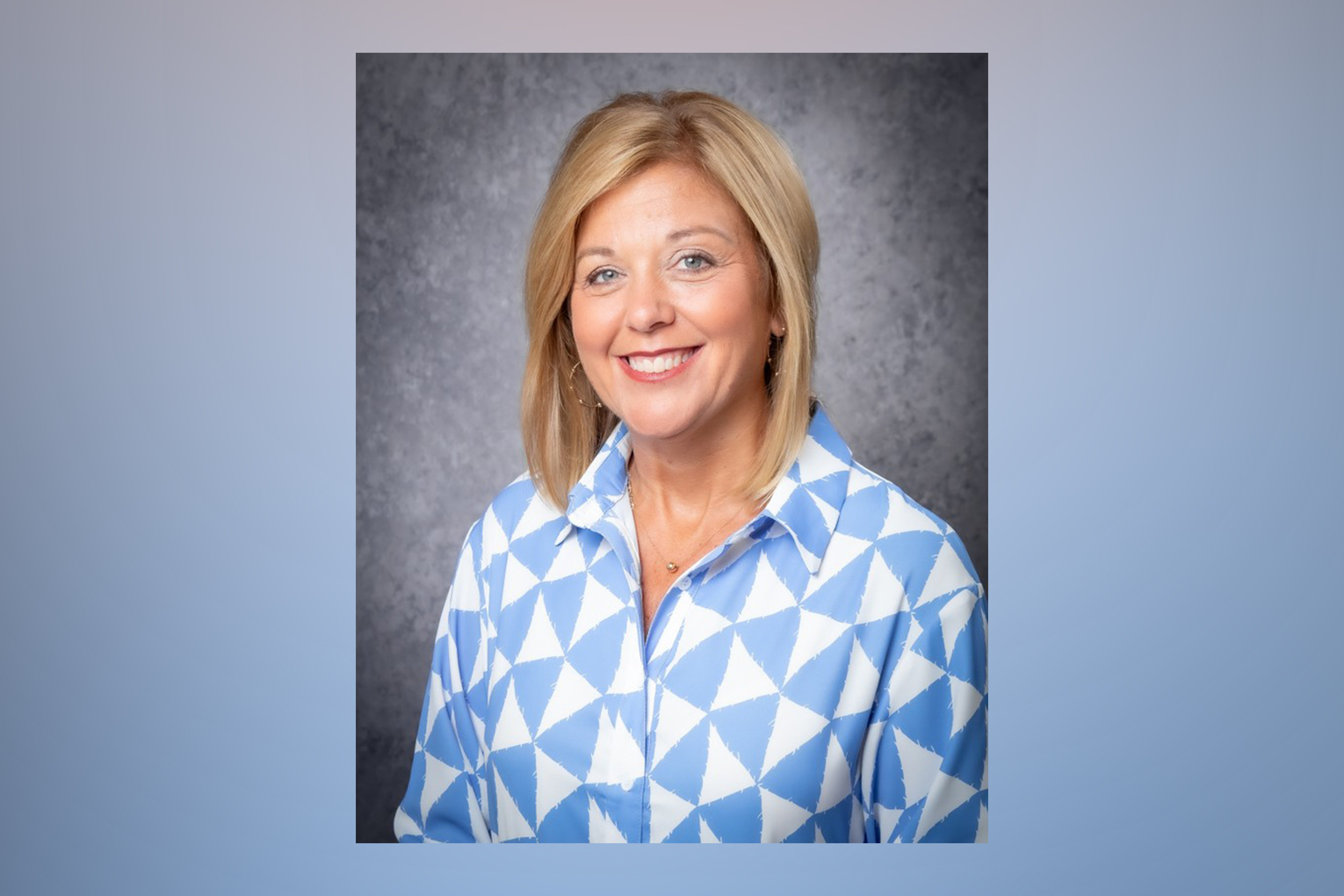
Corbin Primary School (Corbin Independent) was designed so that all of the hallways would flow through the library, making the library the hub of the school.
Photo by Amy Wallot, Dec. 2, 2014
By Brenna R. Kelly
Brenna.Kelly@education.ky.gov
Two 6th-grade students sit on a couch in front of a large, green screen having a conversation about a book. It’s a middle school version of the Today show, with one student playing the role of the book’s author and the other the interviewer.
The camera is an iPad being held by a student recording the interview with an app that superimposes a studio background.
Across the room, other students gather around a long butcher-block table using markers and poster board to create a storyboard of a book’s plot. Against the wall, three students sit at a bank of iMacs designing presentations about a book.
Meanwhile, a 3-D printer is quietly replicating a castle, which was chosen by students to represent a book’s setting.
Jennifer Miller is surveying all of the activity in the Anderson County Middle School library when a little voice pipes up.
“Ms. Miller, I need help finding a book,” the student says.
There are still books here, but like several other schools across the state, Anderson Middle has transformed its library from a place to just check out books to a place where students create, collaborate and use digital media to enhance their learning.
“I’m a big proponent of reading,” said Miller, library media specialist. “But I’m also not naïve as to what they need and what their future is going to hold. We have to prepare them for what their future is, not what our past was.”
The goal of these new libraries, often called hubs of learning or learning commons, is to create an environment where students can develop 21st-century skills – creativity, critical thinking, collaboration and communication – with a librarian leading the way.
“Today’s school library shouldn’t be that old model of a warehouse where books are kept, and there’s someone there to check out the books and make sure they are put back on the shelf,” said Kathy Mansfield, Kentucky Department of Education library media/textbook consultant. “Library media centers are the place to have team meetings, for students to do group projects, for community members, for students and staff to learn about new technology. The library is definitely the location that supports and promotes active learning.”
More and more schools around the state are transforming their libraries into these types of spaces, which are often designed to mimic the collaborative workspaces in Google and Facebook offices.
“Schools seem to be taking more notice of the type of impact that this type of environment can have and pouring funding and resources into their library’s facility, resources and staffing,” Mansfield said.
The state’s guidelines for effective school libraries encourage schools to develop these types of libraries in which librarians have flexible scheduling, up-to-date technology and collaboration with classroom teachers, she said.
Only about 10 percent of the state’s school libraries likely meet all of the criteria for a true hub of learning, Mansfield said, but the percentage increases each year.
Many school librarians, particularly at the elementary level, are hampered by fixed schedules so schools can provide planning periods for classroom teachers.
“We do have librarians that work very hard within the parameters that are set to make this type of learning environment possible,” Mansfield said. Some librarians have set up learning centers that students can use after they have checked out a book during their library time.
Some elementary libraries have added makerspaces stocked with craft supplies, Legos or Lincoln Logs. Other libraries have simply rearranged the furniture to create group workspaces. Shelby County High School created a “Collaboration Zone” with a flat-screen TV that can be hooked into a computer or tablet in what was once a library workroom.
While many schools have transformed their libraries into hubs, Corbin Primary School’s was built that way. Teachers helped design the 7-year-old school with the library at the center. To get anywhere in the school, you have to walk through the train station-themed library, said Susan White, library media specialist.
The large, open space with vaulted ceilings and huge windows is divided into a storytelling area, a creativity center, a book area, a presentation station that can hold 250 people and a computer area with about 30 computers.
White has added learning centers and a measurement station and plans to add more science, technology, engineering and math (STEM) activities.
“At first teachers were like ‘shush, be quiet, this is a library,’ but we were like ‘no, not really,’ ” White said. “The kids do not notice the noise, it was more the teachers, but they are getting used to it now.”
Students at the preschool through second-grade school have never known a library as a quiet place filled with books, she said.
“I think now as we have seen them go through here, they are not used to a regular library concept,” she said. “It’s just very natural.”
But it’s not the space that makes the library the hub of the school, White said. Though her time is scheduled, she has a full-time instructional assistant and a volunteer who works two days a week.
“Having the time to go and talk with the teachers and plan with them and get their ideas and see what they need,” she said, “that is what has made it successful.”
Content and depth
It’s that collaboration with classroom teachers that has made Anderson County Middle’s library transformation work, Miller said.
Miller worked with Jennifer Johnson, a 6th-grade language arts teacher, to create the book project using the library’s new features. Students selected the book, read it on their own and were then placed in groups based on the books.
The groups had to create a storyboard, a 3-D object as symbol of the book’s theme, a Prezi or PowerPoint presentation and a two-minute video. At the end, there will be a parent night to showcase the work, Johnson said.
“They absolutely love it,” said Johnson. “My project covers all of the literature strands and the students have to incorporate those strands into the different projects, so when we have a parent night they will be able to see that we’re just not playing with technology, there’s a lot of content and depth to what their children have done.”
This type of project-based learning that allows students to use technology fits perfectly with the school’s push for more rigor and relevance, Miller said.
“We’re trying to open it up to give students a choice so whatever their passion is, they can use it and feel more confident instead of sitting and taking a written test.”
Cleaning house
Miller began the transformation last summer and it’s still evolving, she said. She started by weeding her dated nonfiction collection, but she did not downsize the fiction section.
“I got rid of nothing that anyone would pick up,” she said. “I wouldn’t do that. I got rid of the stuff that should have been gotten rid of years ago.”
Miller, who is also the school technology coordinator, worked with the principal and district chief information officer to create areas for creation, collaboration, presentation and a quiet area near the fiction books.
In the space now called The Paddock, students can sit on a curved couch and chair set for group discussions, stand around round high top tables or work at three butcher block-topped tables to use the large rolls of paper, markers, glue and other craft supplies.
Square tables became mobile with the addition of casters so they can be rolled into any configuration, and the heavy wooden chairs were swapped out for easily stackable plastic models.
In the presentation area, there is a large projection screen and two flat-screen TVs with Apple TV where students can show off their work.
“The kids have been very into it,” Miller said. “They are very engaged, they are very excited.”
Because the library is not scheduled with daily library classes, teachers can reserve the space on a first-come, first-served basis, Miller said. Some teachers bring their classes to use the technology; some come just for the collaborative workspace.
A few teachers have worried that their students are being too loud in the library, Miller said.
“I’m like, ‘no, I want it to be used,’ ” she said. “That’s the whole point.”
MORE INFO …
Jennifer Miller Jennifer.Miller@anderson.kyschools.us
Susan White Susan.White@Corbin.kyschools.us
Kathy Mansfield Kathy.Mansfield@education.ky.gov
Jennifer Johnson Jennifer.Johnson@anderson.kyschools.us



Great article…Anderson County Middle School is a wonderful learning environment. Way to go Jennifer Johnson and Jennifer Miller.
These are great examples of the type of library we hope to have in all of our Kentucky schools! Thank you to the school administrators and councils who support the type of facility, staffing, scheduling, and budgets to make this happen.